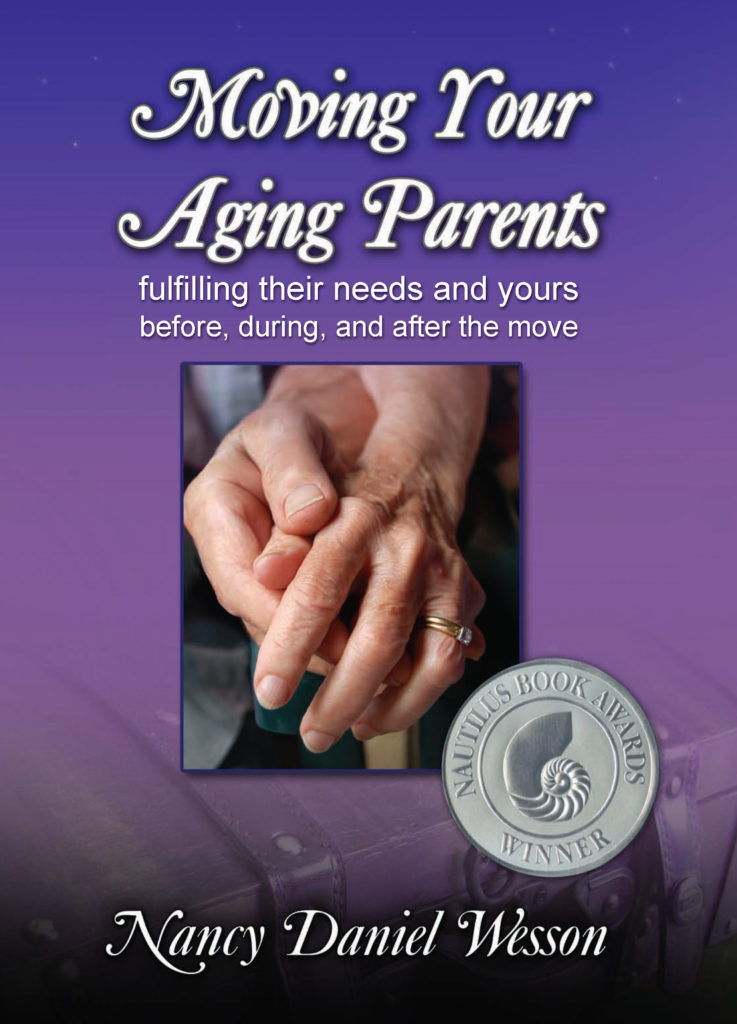Moving Your Aging Parents
Fulfilling Their Needs and Yours
Before, During, and After the Move
About the Book

Moving Your Aging Parents was the result of not only of moving my own mother, but of more than a decade of helping others relocate, down-size, and create beautiful, functional spaces based on their specific needs and dreams for the future. A lifetime of honing an artistic and spiritual bent, coupled with an aptitude for organizing spaces, evolved into a toolbox of synergistic skills as diverse and far afield as the ancient practice of Feng Shui and intuition development to Dispute Resolution, Organization, and Neural Reprogramming.
Combined and tailored to fit each client and their unique challenges, the toolbox offers infinite possibilities for transforming life and allowing us to manage our own energy. I’d applied them all in seminars, business productivity, personal one-on-one consulting, but nowhere did I need all of them more than when dealing with family, specifically, my own mother.
The book will guide you through each of the stages in ways that must might save your relationship, or improve it- as it did ours. Briefly:
Whether we are whittling down to the essentials for a parent moving into a few rooms or downsizing for ourselves, making decisions based on health and safety alone could have devastating emotional and spiritual consequences. This hope-filled book will show you how to:
- Identify needs and desires to create a quality life
- Cope with Depression Era mind-set
- Create emotionally sustaining environments to feed the soul
- Ready and sell the family home
- Ask the RIGHT questions to help divest of treasures
- Manage your energy and spirit throughout the process.
Awards
- Nautilus Book Award: Silver; Relationships Category
- Nautilus Small Press Award
- Reader Views First Place: Aging and Retirement Category
- IBPA Next Generation Book Awards; Finalist in two categories: Spirituality & Aging
Foreword
by Jacqueline Marcell, Author of Elder Rage: How to Survive Caring for Aging Parents; host of the Coping with Caregiving radio show
This book is a treasure trove of practical tools, valuable insights and heartfelt hope. Nancy shares her eldercare experience (which most of us will have with our own aging parents) through rich and honest stories and practical, compassionate guidance centered around moving her own mother. Through creative techniques developed over decades of working with clients and students, she not only shows us how to help our parents’ transition to their new life, but also offers a sensitive guide for creating a whole new way for living it.
Early on, Nancy makes the statement that “After physical needs are met, this endeavor [moving our parents] has far more to do with the spirit than at any other time of life.” Far from offering platitudes, Nancy offers a valuable, heretofore unavailable blend of practicality and inspiration.
Her real-life stories are profoundly moving, but she doesn’t take the easy road and stop there. She offers us the real tools—all practical, some original, some taken from other research and disciplines and exquisitely adapted to this phase of life. Some are geared to getting our parents on board and engaged in the possibilities; others act as a lifeline to pull us, their children and helpers, out of the quicksand of competing responsibilities and make it possible to help with grace and wisdom.
At the core of such transitions are deeply conflicting feelings and the need to communicate from the heart. But schedules, fears, old wounds, personal needs, grief, fear and egos act as obstacles to our providing the comfort and support we intend. Nancy offers very specific techniques and skills to guide us through not only the difficult conversations with our parents, but our own internal dialogues as well. She offers deep insight into the divergent histories that have created the often-conflicting mindsets and values that make even talking about this move so heart-wrenching. Nancy’s understanding of these issues and the guidance she provides offer us a way to be gentle with our parents and still move forward with the task at hand. Her shared experiences with her mother and her clients are proof that it is possible to transform this event. Instead of it being on-the-job-training which we must endure and survive, it really can be a positive, life-healing experience—ushering us into an increasingly rich and fulfilling adult relationship with our parents.
The processes presented in this book apply even if we are not physically relocating our parents. They are just as appropriate when applied to a new stage of life in their own homes. Her book offers a great many things we can do to help them age-in-place and remain at home longer—maintaining their dignity and independence as long as possible and on their terms. In the chapter on Special Needs, Nancy identifies behavioral characteristics to help with early identification of some of the maladies that complicate later life and have been at the root of premature nursing home placements. There are many simple environmental adjustments that can make life easier and safer for those living with hearing loss, arthritis, dementia, Parkinson’s or low-vision. In addition to nurturing autonomy and personal dignity, they might well defer a move into more restrictive accommodations.
One of the comments I hear repeatedly in working in the realm of elder-care is that “Mom and Dad are just not adjusting well to the move.” Most books stop with “moving in.” This book goes far beyond and uses diagrams and stories to show us how to set-up the new residence and help them feel “at home.” Her ideas about re-claiming daily rituals to help them bond with their new lives are compelling. And the tips on where to go and who to con-tact to help our folks build new connections and friendships are true life-savers.
Nancy is a believer that quality of life and quality of environment are inseparable and she shows us with amazing clarity how thought, emotions and environment combine to help people create emotionally rich and sustaining lives regardless of circumstances or age. She shows us how to work with what we have, and turn the-hand-we-have-been-dealt into one that serves us and those we love throughout and long after the physical transition.
In reading this book, it became clear that Nancy has a unique ability to merge a wide range of seemingly divergent topics and skills into a whole that not only makes sense, but is inspirational. With compassion, humor and insight she tackles conflict resolution, spirituality, organization, interior design, space-planning (Feng Shui) and special needs—and presents the whole lot in an orderly, logical manner. In doing so she expertly guides us around every eldercare obstacle, while teaching us how to effectively communicate and negotiate with loved ones born of a different era. Ultimately she leads the reader through a process of discovery that can be life-changing. By the end of the book we realize this book goes far beyond just the task or relocating: it offers a blueprint for living a purpose driven life.
Praise for Moving Your Aging Parents
Author Face Reading in Chinese Medicine
